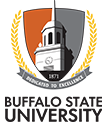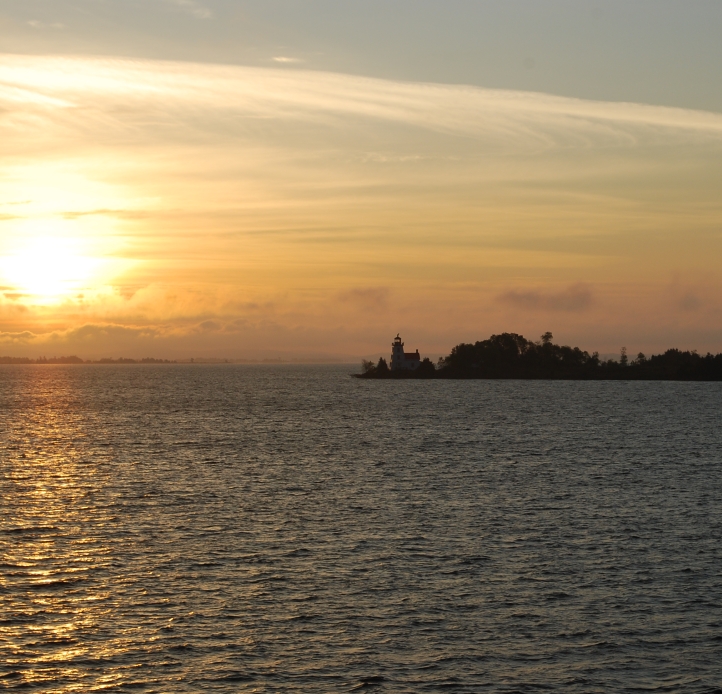
Great Lakes Center Newsletter: Issue 27
November 17, 2025
This issue is the largest one yet, opening with a word from our interim director Dr. Chris Pennuto. We cover our summer research trips, including the five-lake survey of the Great Lakes, an intensive look at Lake Michigan, and the search for Diporeia in the Finger Lakes, as well as a fall research trip to the Republic of Georgia looking at the genetics of freshwater unionid mussels. We check back in with the Emerald Shiner Project, which has advanced to the installation of fish passage in the Niagara River. WNY PRISM describes their early detection program, and the Field Station reports some of their current projects and visitors. GLC affiliate Dr. Stephen Vermette gives a peek at an upcoming paper, we give a rundown of recent GLC news, and we shine the spotlight on one of our graduate students.
Great Lakes Center: Traditions and Transitions
by Dr. Chris Pennuto, Interim Director

The year 2025 represents the 59th year of operation for the Great Lakes Center. In that time, it has seen many changes in its operations, the issues faced by the lakes and in turn the research emphases of its personnel, and even its physical footprint. In 1965, Dr. Howard Sengbusch made the case to SUNY for establishment of a Great Lakes Laboratory (GLL) to:
… “offer faculty and students opportunities to study the basic factors of production and metabolism, at all trophic levels, in standing and running waters, both natural and artificially changed. Such a program, encouraged and supported by the State University of New York, would be of inestimable value not only to the College, but also to the community and to New York State.”
Thus, the GLL was approved for creation in 1966 and was expected to operate under three umbrella directives: research, education, and cooperation/coordination. Research meant to “expand and diversify research conducted by the Center, but with a focus on the unique ecological issues within the Great Lakes basin.” Education was to “focus on providing students with unique opportunities for hands-on training in environmental management that would significantly broaden their educational experience, job prospects, and ability to make informed decisions.” And cooperation/collaboration would “stimulate intellectual growth for students and faculty, foster increased collaborations among units within the college and between the college and other institutions, and serve the regional community as a technical and intellectual resource for resolving environmental issues and for continuing education and specialized training.” Since its inception, these three directives have seen some changes in their relative emphasis, but the expectation for these directives has not altered. The union of both basic and applied water research has been the Center’s tradition over the nearly 60 years since inception. Though periods of transition have occurred as research expertise ebbed and flowed with the issues facing the lakes, with changes in leadership and key personnel, or with changes in the funding landscape, research engagement, both applied and basic, has been a foundation.
Since inception the Center has transitioned through several names changes; the Great Lakes Laboratory from 1966 until 1989; the Center for Environmental Research and Education (CERE) from 1989 until 1994; and the Great Lakes Center from 1994 to present. Also in this time frame, six individuals have served as Director for more than a year (there were several Interim Directors), each leading a transition into a different emphasis for the Center. Under the direction of Dr. Robert Sweeney, the Center focused on water quality and invertebrate communities of the Buffalo River. Dr. Harish Sikka then led the Center toward environmental toxicology and mechanisms of carcinogenesis of environmental toxins. The directorship of Dr. Charles Beasley saw a period of rapid infrastructure change with facilities build-outs, and greater involvement of other campus and regional partners, while renewing a focus on fisheries. Dr. Stephen Brandt turbo-charged research in fishery ecology, bioenergetic modeling, and hydroacoustics. Dr. Gordon Frasier brought Center activities back to the Buffalo River and water quality concerns. Next, Dr. Alexander Karatayev, the longest serving director in the Center’s nearly 60 years, established the Center as a powerhouse for invasive species ecology, especially the role of dreissenid mussels in lake ecosystems. Thus, over nearly 60 years, the Center has transitioned in name and research emphasis, but has remained a vital part of Buffalo State, the Western New York region, and the Great Lakes community.
Research and research-informed education remain the priority of personnel in the Center, and it is necessary to seek extramural funding to support those activities. Like the Center itself, the availability of that funding, the level of competitiveness to win awards, the federal or state emphases for assistance, or the maximum allowable indirect rates have all transitioned over time and with changes in federal administrations. For example, in the early years of the Center, federal funding was near zero as financial resources were diverted to the Vietnam War effort, but the mid-70’s saw significant funding opportunities as environmental regulations were enacted to overcome decades of unabated pollution. Today, another sharp curtailment of federal funding is at hand that will require some navigation. As the Center matures beyond its 60 years, our traditions will remain, but some transitions will be needed; continuation of what we currently excel at (like invasive species research) coupled with strategic pivots and diversification of funding sources we approach and the workforce we bring to bear. Opportunities might be had in expansions of our biomonitoring expertise, some return to local and regional applied water quality investigations and building regional collaborations and partnerships for those investigations, encouraging cross-disciplinary activity with a broad sense of linkage to the Great Lakes watershed, reinvention of our role in leading environmental, aquatics-oriented education and training of undergraduate and graduate students, regional teachers, and natural resource professionals, capitalizing on our collective institutional strengths where it makes sense to do so, or leaning further into our lake monitoring technology. Thus, as we move beyond 60, we will be guided by our traditions and recognize our long history of transitions that have allowed us to meet the environmental challenges present throughout the Great Lakes and their watersheds.
GLC gets the benthic inside scoop during summer survey
by Susan Daniel and Kaira Kamke
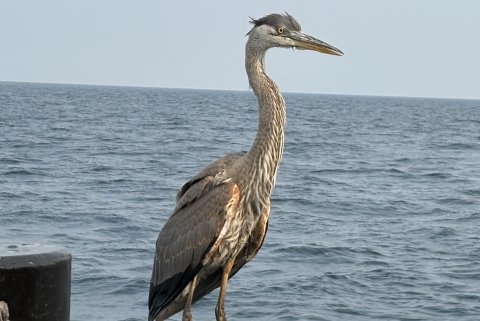
The Great Lakes Center successfully completed another Long-Term Monitoring survey aboard the R/V Lake Guardian in August this year as a part of the Great Lakes National Program Office (GLNPO) Biology Monitoring Program. The ship set sail from Milwaukee, Wisconsin, on August 1, with scientists Susan Daniel and Lauren Martinek on board for the first leg of the trip. They started in Lake Michigan and continued through Lakes Huron, Erie, and Ontario, before coming to port in Rochester, New York. During this first leg, Susan was interviewed by Let’s Go Door County, a local news channel on social media, while docked in Sturgeon Bay, Wisconsin. Susan explained the impact of invasive species (particularly quagga mussels) and the importance of monitoring programs to understand their impact on the environment and ultimately human health. The next day, while sampling northern Lake Michigan near North Manitou Island, a juvenile great blue heron landed on the ship. Looking exhausted, it rested onboard for a while then flew back in the direction of the Island.
For the second leg of the trip, the Lake Guardian departed from Rochester to head back through the Welland Canal toward Lake Superior. Lauren returned for this final leg along with Kaira Kamke, who was able to experience her first excursion on the ship this year. Lake Superior provided the desired views of vast starry nighttime skies and picturesque sunrises and sunsets. Part of the route went along the Apostle Islands, so the scientists and crew were able to appreciate this National Lakeshore area from the water. After a highly appreciated half-day stop in Duluth, the survey continued north along the Canadian shore toward Isle Royale and concluded back in Sault Ste Marie, Michigan, on the morning of August 28. Both legs of this survey were completed slightly ahead of schedule due to mostly favorable weather and an efficient team of scientists and crew members. A total of 183 benthic samples were successfully collected from 61 stations, only omitting one station on Lake Superior because of high wind and wave levels.
During this survey, GLC staff were joined by scientists from other institutions and were able to assist with additional research projects. Dr. Diana Aga and Elise Enova, from the University at Buffalo (UB), collected samples on this survey to test the water, sediments, and Dreissena tissues for per- and polyfluoroalkyl substances (PFAS) and total organofluorine (TOF). These chemicals are used in many common products and persist in the environment for long periods of time. These samples will be used to better understand the bioaccumulation potential of these compounds. Another project conducted during the survey this year involved collecting benthic invertebrates and sediment samples for metabarcoding. This project, coordinated by Lyubov Burlakova and Alexander Karatayev, is aiming to sequence the genetic code for invertebrates found in the Great Lakes and improve the ability for detecting these species using composite sediment samples.
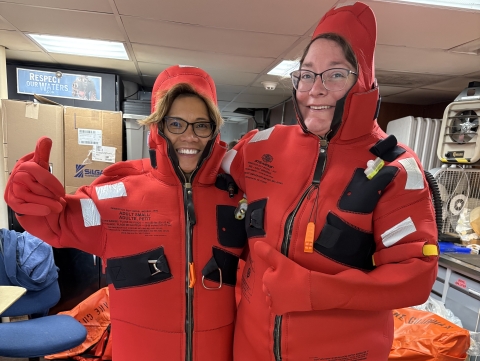
Exploring Lake Michigan: Great Lakes scientists conduct CSMI survey
by Nikolai Barulin, Kaira Kamke, Lyubov Burlakova, and Alexander Karatayev
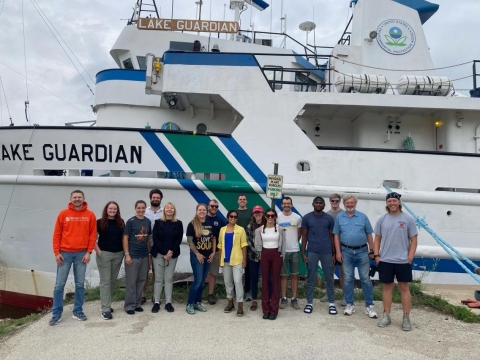
In July, a team of scientists from the GLC boarded the R/V Lake Guardian in Milwaukee, Wisconsin, to conduct the Cooperative Science and Monitoring Initiative (CSMI) benthic survey on Lake Michigan, following previous surveys in 2015 and 2020. This year’s benthic team included project PIs Lyubov Burlakova and Alexander (Sasha) Karatayev, Research Scientist Nik Barulin, Vadim Karatayev from the University of Maryland, independent researcher Lauren Martinek, and our recent addition to the team, taxonomist and research technician Kaira Kamke.
During the two-week survey, Sasha and Vadim (day shift), Lyubov and Kaira (evening shift), and Nik and Lauren (night shift) aimed to collect over 300 samples from 108 locations. The focus this year was to monitor the benthic fauna, particularly the quagga mussels (Dreissena rostriformis bugensis) and zebra mussels (Dreissena polymorpha) that have altered the lake environment over the past 30 years. In addition to traditional sampling methods, video recordings of the sediment surface were used to gather near real-time information on quagga and zebra mussel distribution.
The GLC team assisted a team from Mar L. Schmidt’s lab from Cornell University’s Department of Microbiology in collecting samples to identify the physical and ecological determinants of Lake Michigan’s microbial community structure and function. Our team also collected dreissenid samples for our collaborators from SUNY Brockport for evaluation of thiamine deficiency in lake whitefish as a potential cause of their recruitment failure, part of the Great Lakes Fishery Trust (GLFT) Lake Whitefish Project (PI Jacques Rinchard). Graduate student Ahmed Ogidan, from Wright State University, continued his work from Lake Erie last year by collecting algae to quantify differences in the algal communities inhabiting soft sediments and growing attached dreissenid mussel shells across depth gradients in Lake Michigan. A separate team from the National Oceanic and Atmospheric Administration, including Paul Glyshaw and Rachel Orzechowski, continued their work from previous CSMI years to examine morphological and reproductive changes in quagga mussels across different depths and food gradients. Lastly, Karen Baumann, graduate student from the University of Wisconsin-Milwaukee, measured dreissenid stable isotope signatures and excretion and egestion rates.
Through the continued work of the CSMI to investigate the complex processes shaping Lake Michigan’s ecosystem, our collective research will illuminate the changes occurring below the surface. The outcomes of this study will advance our comprehension of how invasive species and environmental pressures influence the lake, offering essential guidance for future management and conservation planning.
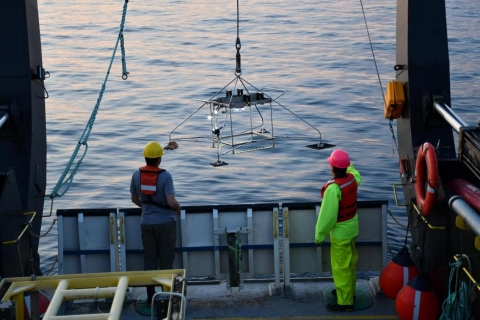
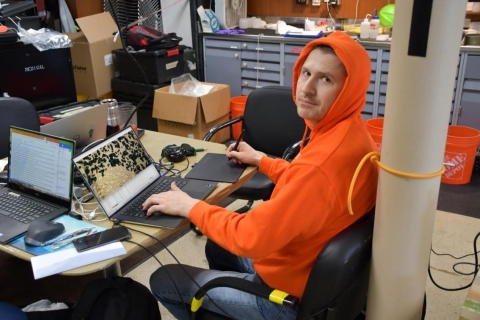
Finding Diporeia: A unique survey of the Finger Lakes
by Nikolai Barulin, Lyubov Burlakova, and Alexander Karatayev
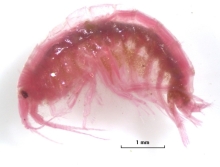
In August 2025, a Great Lakes Center team, led by Sasha Karatayev and including Lyuba Burlakova, Nik Barulin, Brian Haas, and Ben Szczygiel, conducted a unique survey across New York’s Finger Lakes to assess the current status of Diporeia populations.
The benthic amphipod Diporeia hoyi, a glacial relict, is a keystone species in deep lakes. It often dominates benthic communities, plays a crucial role in nutrient cycling and food webs, and supports many commercially and recreationally important fish species. However, the invasion of zebra and quagga mussels in the late 1980s caused Diporeia populations to collapse throughout the Great Lakes, except in Lake Superior. By 2018-2021, Diporeia densities had declined 60- to 600-fold in Lakes Ontario, Michigan, and Huron, and the species has not been recorded in the eastern basin of Lake Erie since 1993.
Interestingly, Diporeia and Dreissena were reported to coexist in several Finger Lakes a decade ago (Watkins et al., 2012). To evaluate their current status, we repeated Jim Watkins’s 2009 survey of six Finger Lakes, 15 years later and more than 25 years after dreissenid introduction. Our goal was to assess the long-term effects of quagga mussels on Diporeia populations.
We found that quagga mussel densities in studied lakes were within the range reported from the Great Lakes. Although Diporeia densities declined significantly across all Finger Lakes by 2025, the reductions were far smaller, only 2- to 10-fold, compared to the dramatic collapses in the Great Lakes. The degree of decline did not correspond to invasion history: Cayuga Lake showed the smallest decline (2-fold), while Seneca Lake showed the largest (10-fold), despite both having long histories of quagga mussel presence.
This survey, supported by the Ruth Huppuch Great Lakes Center Endowed Fund, forms part of a larger effort to synthesize the fate of Diporeia across North America. The resulting review, “Could invasive dreissenids drive the deepwater amphipod Diporeia to extinction? A synthesis,” is expected to be published next year. Stay tuned!
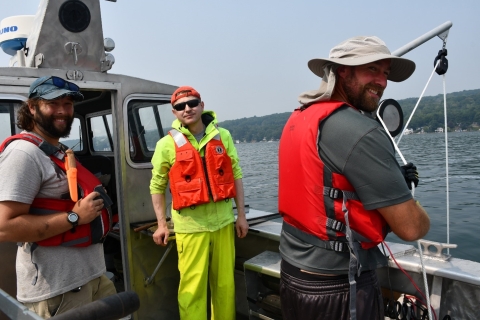
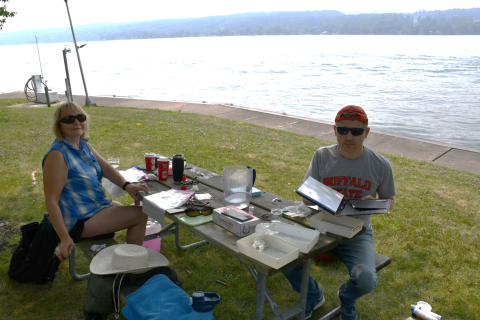
International mollusc survey in the Republic of Georgia
by Lyubov Burlakova and Alexander Karatayev

In October 2025, Lyuba Burlakova and Sasha Karatayev participated in an international survey of freshwater bivalve molluscs from family Unionidae in the Republic of Georgia, a region where these species have been little studied over the past 50 years. Historically, Georgian rivers were believed to harbor several species including Unio crassus or Unio crassus complex, but recent evidence suggested the possible presence of a distinct Unio species. To check this hypothesis, an international team of scientists including Manuel Lopes-Lima from CIBIO/InBIO - Research Center in Biodiversity and Genetic Resources in Portugal, Maria Urbańska from University of Life Sciences in Poznań, Poland, Nicoletta Ricciardi from Italian National Research Council, and Lyuba Burlakova and Sasha Karatayev from Buffalo State spent two weeks sampling Georgian rivers and lakes.
The team was hosted by our Georgian collaborator Dr. Levan Mumladze, Director of the Georgian Institute of Zoology. During our trip we sampled about 30 waterbodies and collected 168 specimens of unionids representing at least 4 species. Over two weeks, our team covered a large part of Georgia, from the Black Sea coast to the mountain regions, searching for mussels in deep, muddy ponds and shallow, fast-flowing streams. Some places were easy to sample and 10 specimens (the number required for DNA samples) were collected within a half hour, while others took hours of effort. After collection, a small clip of tissue was taken from each mussel and preserved in alcohol, and the individuals were returned to their habitat. This non-lethal technique was developed during previous field trips.
Our typical day usually started with a hearty Georgian breakfast, followed by long drives through beautiful mountain landscapes glowing with fall colors. Fieldwork was often intense, and dinners, usually late, were always rewarding, featuring delicious Georgian cuisine (well-deserved after skipping lunch) and lively discussions about future papers and surveys. In total, we drove more than 2,000 kilometers, including off-road areas that challenged our vehicle, which began making alarming noises toward the end of the trip. Fortunately, our skilled driver, Levan, managed to keep it running smoothly with on-the-spot repairs. Overall, the expedition was a great success and an unforgettable experience. The results will contribute to several forthcoming publications and a revision of the regional unionid taxonomy. We gratefully acknowledge support from the Ruth Huppuch Great Lakes Center Endowed Fund, which made this work possible.

From research to results: Emerald shiner fish passage installed
by Kit Hastings

A project started a decade ago is bearing fruit: Fish passage is being installed in the upper Niagara River to allow juvenile emerald shiners (Notropis atherinoides), a keystone prey species, to complete their annual migration back upstream toward Lake Erie.
The Emerald Shiner Project began as an exploration into an under-studied prey fish relied on by sport fish and migratory birds in the Niagara River. There was no current population estimate or catalogue of its habitat use in the upper Niagara River in 2013, aside from local knowledge. Dr. Alicia Pérez-Fuentetaja and Field Station manager Mark Clapsadl led graduate students from Biology and GLES in employing several fishing techniques to look for emerald shiners of all life stages in tributaries, wetlands, marinas, and gyres. They also led outreach efforts in collaboration with Buffalo Niagara Waterkeeper through events, social media, and a website. Our collaborators at the U.S. Army Corps of Engineers characterized substrates, vegetation, and water velocities, while researchers from University at Buffalo calculated their maximum swimming velocity. Through this work, we identified a significant barrier to the annual upstream migration of juvenile fish: a section of concrete wall along Unity Island in the Niagara River where water velocity was too high, and only a small fraction of young fish were able to make it upstream.
After the 2018 field season, GLC researchers used samples collected during the Emerald Shiner Project to discover pharmaceuticals in the brains of sport fish in the Niagara River, and then studied novel methods to remove pharmaceuticals from wastewater treatment plant effluent. The Army Corps kept working with local partners on the emerald shiners. In 2022, a pilot fish passage project designed by UB was installed in a 78 ft section of the barrier at Freedom Park on Unity Island: baffles that would roughen the shoreline to slow the velocity and create refuges for exhausted fish. The full project, started in March 2025 with estimated completion in late 2026, will employ baffles along the full 700 ft barrier.
This July, early project partners were invited by the Army Corps to the construction site at Freedom Park for a site visit and project update. Kit Hastings attended for the GLC since Alicia and Mark recently retired and the other Field Station personnel who worked on the project, Brian Haas and Ben Szczygiel, were out doing fieldwork. Also in attendance were UB, NYS Department of Environmental Conservation, the president of the Friends of Freedom Park, and many scientists and engineers from the US Army Corps of Engineers. The meeting was a celebration of the work we collaborated on to achieve habitat restoration and an opportunity to reconvene and think of ways to share our project successes with other waterway managers. This critical fish passage will hopefully contribute to delisting the Niagara River as a Great Lakes Area of Concern (AOC) someday soon. It was rewarding to visit the construction site and celebrate our collective success!
Paddling ahead of the problem: Early detection efforts to protect our waterways
by Rachel Taylor
In Western New York, our waterways are more than just scenic views — they’re crucial to our environment, economy, health and way of life. But they’re also under threat from aquatic invasive species that don’t announce their arrival. Staying one step ahead, WNY PRISM and our partners can catch problems early, making all the difference.
The best time to address an invasive species is before it settles into a new area. That’s the principle behind Early Detection and Rapid Response – a proactive and coordinated approach to finding, documenting, assessing and removing invasive species before they become established. It’s not feasible to manage every new aquatic invasive species that arrives in the region and that’s where WNY PRISM’s priority species list comes in. Early detection priority species are high impact species that have low abundance and available management making eradication feasible within the region.
With a prioritized species list in hand, management efforts focus on eradicating those species from the region by responding to newly reported infestations and returning to early detection sites each year to implement site monitoring and removal efforts. A site is presumed eradicated when the species has not been found for a minimum of five consecutive years. Each field season, WNY PRISM staff conduct early detection site monitoring and removal efforts to ensure these areas are free from priority aquatic invasive species.
WNY PRISM’s aquatic early detection efforts have recently focused primarily on water hyacinth (Oshuna crassipes) and water lettuce (Pistia stratiotes), two species commonly sold for use in water gardens. When infestations of these species are small, it’s effective to manage them by hand pulling or by collecting plants with nets or pond rakes. Both species have been present in the region since 2001 and 2011, respectively. For water hyacinth, survey and management efforts began by partners in 2014, with WNY PRISM expanding on these efforts since 2016. WNY PRISM initiated management for water lettuce that same year.
Four water hyacinth sites are presumed eradicated, but active sites remain at Oppenheim Park, Tonawanda Creek/Erie Canal, Buckhorn Island State Park, and Dunkirk Harbor, the latter two being monitored and managed by partners. WNY PRISM removed six plants from Oppenheim Park in 2020 and thirty-eight plants from the Canal in 2021. No plants have been found since. Active water lettuce sites include Hyde Park Lake, Ellicott Creek and Tonawanda Creek/Erie Canal. WNY PRISM removed 730 plants from Hyde Park Lake in 2020, 148 plants from Ellicott Creek in 2021 and thirty-eight plants from the Canal in 2021. No plants have been found since.
While no early detection aquatic species were found during this year’s site monitoring, two new sites were identified thanks to two iNaturalist reports of water lettuce – in Walton Woods Park and Tifft Nature Preserve. WNY PRISM staff surveyed both sites and removed 601 water lettuce and twenty-nine water hyacinth plants from Walton Woods Park and eighty-one water lettuce plants from Tifft Nature Preserve. Both sites will be monitored moving forward.
Originally appeared in the WNY PRISM Fall Newsletter (PDF). Republished with permission. Photo credit: WNY PRISM.

Something about the month of November!
by Stephen Vermette, GLC affiliate
A Buffalo Enquirer article published on November 19, 1909, titled: “Season of Lake Disaster is Here,” highlights the risk to shipping on the Great Lakes. The month of the publication and mention to “is here,” suggests that there is something about November. The sinking of the Edmund Fitzgerald on November 10, 1975, made famous by Gordon Lightfoot’s ballad “The Wreck of the Edmund Fitzgerald,” includes several references to November: “Gales of November comes early;” “Gales of November came slashin’;” “Gales of November remembered;” and “Witch of November comes stealing.”
A sampling of archived shipwreck numbers reveals that there is indeed something about the month of November which stirs up the waters of the Great Lakes, often characterized by the carnage of shipwrecks.
These numbers, the weather science behind them, and Buffalo’s link to its harbor and, by extension, the Great Lakes, are explored in an upcoming article to be published in the Western New York Heritage Magazine (Fall, 2026).
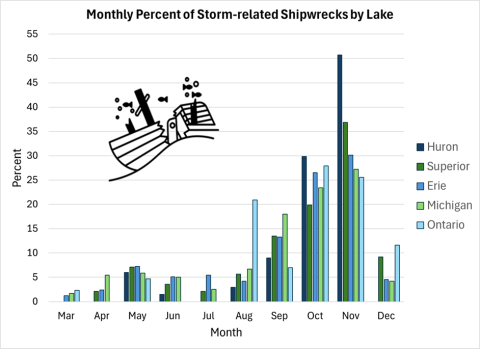
Happenings at the Field Station
by Brian Haas and Ben Szczygiel
New weather/data buoy coming to Buffalo
The GLC has recently been awarded funds from the Niagara River Greenway Commission to purchase and operate a new weather/data buoy in the Eastern Basin of Lake Erie, approximately 2 miles outside of the city of Buffalo. This buoy will provide real time wave and weather conditions, as well as water quality and temperature profiles. It will also be equipped with a webcam that can give views of the lake and cityscape offering the community a great public resource. More details to come in the Spring Newsletter.
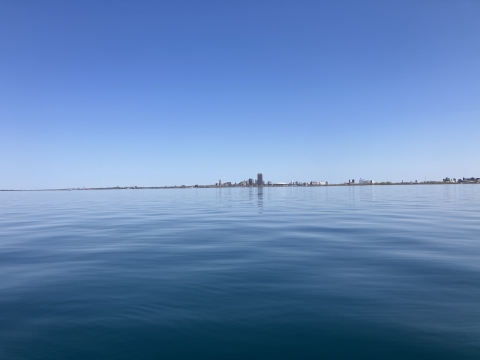
Lake Erie nearshore sampling
We carried out subcontracting work for the Susquehanna River Basin Commission (SRBC) for the EPA’s National Coastal Condition Assessment. The SRBC scientists who predominantly work in river systems reached out to us to utilize our specialized vessels and skillset on the Great Lakes. The work included water, benthic, and fish sampling along the shores of Lake Erie from two of our research vessels during the month of July.
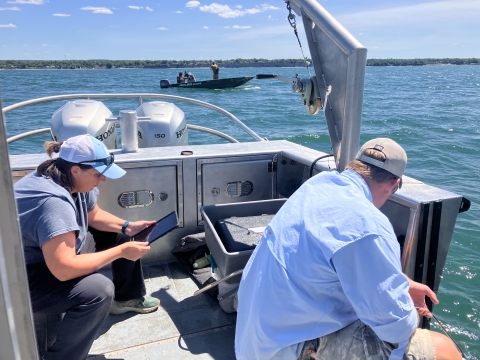
Continued interdisciplinary collaborations
Art students working with Dr. Dave Mawer from the Art and Design department visited the Field Station this fall. Their visit consisted of an excursion into Buffalo Harbor where they collected photo, video, and audio recordings of Lake Erie for a group project. The windspeed and wave conditions that day offered great opportunities to capture the sights and sounds of the lake.

New club visits the Field Station
by Stephen Vermette, GLC affiliate
Brian Haas kindly opened up the Field Station for a tour by the EcoBengals Club. We boarded the R/V John J. Freidhoff for a trip up the Buffalo River. EcoBengals is a campus student environmental club, housed within Geosciences, but open to all students with an interest in environmental issues.

News highlights
by Kit Hastings
Sasha Karatayev, Lyuba Burlakova, adjunct researcher Richard Barbiero, and their collaborators were awarded the Chandler-Misener Award for their paper, “The benthic nepheloid layer in the offshore waters of the Great Lakes and its post-dreissenid disappearance.” The Chandler-Misener Award is presented annually to authors of a peer-reviewed paper in a current volume of the Journal of Great Lakes Research judged to be “most notable.”
Dr. Chris Pennuto was selected for the SUNY Research Leadership Academy, a program that helps researchers communicate research directly and vividly to different audiences. He was one of approximately 30 SUNY faculty members whose work exemplifies excellence in science, technology, engineering, mathematics, and medicine (STEMM) research and leadership.
The Great Lakes Center participated in the Annual Autumn Equinox Pumpkin Drop, sponsored by the Geosciences Department, and came home with the trophy for Best Decorated. Our pumpkin was designed and carved by Angela and Brianne Tulumello. Other pumpkins were submitted by student clubs and Athletics, and one was signed by participants for good luck. While spectators drank cider, Dr. Stephen Vermette went up to the roof of Buckham and dropped the pumpkins to loud cheers. Photo gallery.

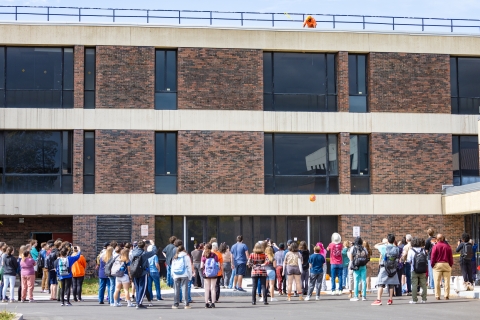
The Great Lakes Center was featured in a Buffalo State article, “Five things to know about Buffalo State’s Great Lakes Center,” which provides an excellent introduction of what we do.
Former GLC researcher Allison Hrycik and Biology graduate alum Kira Yirofeev were interviewed by WIVB about their work with the Jefferson Project to sample Chautauqua Lake to monitor for harmful algal blooms.
Biology graduate alum and former GLC research assistant Kyle Glenn is now stream restoration specialist for Trout Unlimited. Kyle was featured in a short film “Connected Conservation: A Future for Adirondack Brook Trout,” which released last spring.
On October 23rd, there was a huge water level drop at the Field Station due to a seiche, following several days of high winds. The seiche made news the day before at the other end of the lake. "What's a seiche? Strong wind gusts often rock Lake Erie's waters. What happened this week" covers this phenomenon, as well as pictures and video of low water levels in the western basin.
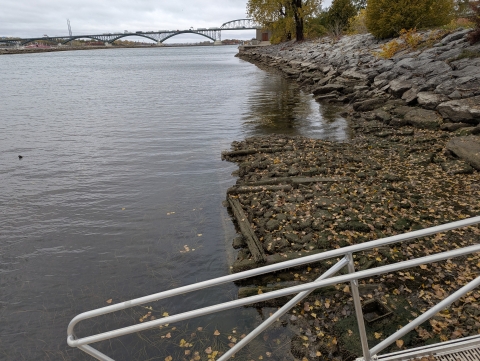
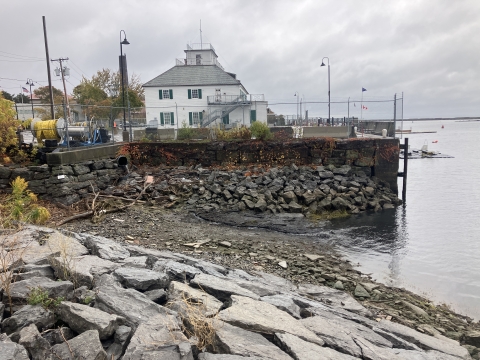
There are still a few GLC/Bio Seminars for the semester. Seminars are on Mondays at 3pm in SAMC 151. Check the fall seminar schedule.
GLES Student Spotlight: Emily Klimczak
by Dr. Chris Pennuto
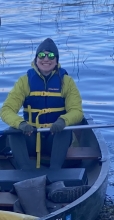
The Great Lakes Environmental Science graduate program turned 10 years old in 2023. Since our inception, we have had 45 graduate students in the program in either the thesis or internship tracks. This column is an opportunity to highlight the accomplishments of one of those students, past or present.
Emily Klimczak completed her thesis in the Great Lakes Environmental Science program in spring 2025. Her thesis, “The fight against red swamp crayfish (Procambarus clarkii): Examination of the implementation and efficiency of intensive trapping and the winner-loser effect as management techniques,” explored the winner-loser effect for its potential as a new management approach to the management of invasive crayfish. The winner-loser effect is a mechanism involved in the establishment of dominance hierarchies in populations of a wide range of animals, including crayfish. She used this mechanism to ‘train’ native crayfish to be winners and then pitted them in competitive interactions with invasive crayfish. Although in the end, trained crayfish did no better than untrained individuals, her work shed new light on food as a motivating factor for the success of the invaders.
As part of her thesis work, she worked with science teacher Adrienne DeGroat at the Park School to give students an opportunity to engage in crayfish management activities. She provided guest leadership in several classes to instruct students on basic crayfish collection protocols, and collection of a suite of standard measurements. Since completing her thesis, Emily has been employed in a term biologist position with the US Fish & Wildlife Service at the Iroquois Refuge in Basom, NY. She and her advisor, Dr. Chris Pennuto, recently submitted her work for publication in the journal Biological Invasions. Her prospects are good for continued employment in natural resource conservation fields, and in positions related to invasive species management. We wish her the best in her future endeavors.
